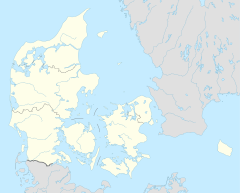Vesborg

Aerial view of Vesborg Lighthouse
|
|
|
Denmark
|
|
| Location | Visborg, Samsø Denmark |
|---|---|
| Coordinates | 55°46′12″N 10°33′03″E / 55.769897°N 10.550874°E |
| Year first constructed | 1858 |
| Construction | masonry tower |
| Tower shape | cylindrical tower with balcony and lantern |
| Markings / pattern | white tower, red lantern dome and trim |
| Height | 19 metres (62 ft) |
| Focal height | 36 metres (118 ft) |
| Admiralty number | C0842 |
| NGA number | 2340 |
| ARLHS number | DEN-046 |
| Denmark number | DFL-2230 |
Vesborg was a castle founded by King Valdemar Atterdag in the 1360s, on the southwestern coast of Samsø in Denmark. The castle does not exist anymore and a lighthouse was built on the site in 1858.
Vesborg was initiated after the destruction of Brattingsborg Castle in the year 1289. The crown lacked a stronghold on this strategically important island and Vesborg was their remedy. It was built above 20 m tall coastal cliffs on a huge artificial hill and with a good view of the nearby sea and landscape. It gave a good view of the entrance to the straits of Lillebælt and Storebælt and large parts of the southern Kattegat sea. Few written sources mentions Vesborg, but in the wars around 1370, when Denmark faced the hostile coalition of Sweden, the Hanseatic states, the Duchy of Mecklenburg and the County of Holstein, the knight Henrik von der Osten, is mentioned as the kings Lord Lieutenant at Vesborg. After the Danish defeat, Vesborg lost its importance and was abandoned, perhaps even before it was finished. The castle was the largest of the five known medieval castles on the island of Samsø and the castle hill is one of the largest in all of Denmark.
Today almost all of Vesborg, has collapsed and tumbled into the sea below, the last part of the walls apparently fell under a storm on the Christmas Eve of 1875. The only remains, is a small part of the foundations of the gate tower, that would have guarded the drawbridge over the impressive moat, that was up to 10,5 m deep and 20 m wide and is particularly well preserved. The access road is located on the Eastern hill, it is 4 m wide, cobbled with small stones and shows no signs of wear.
...
Wikipedia

